Crystal Mountain: A PT’s Guide to Prepping for Steeps, Variable Snow, and Big Days
Crystal Mountain: SkiPT’s Guide to Prepping for Steeps, Variable Snow, and Big Days
In collaboration with Crystal Mountain
Written by: Greg Louie, Doctor of Physical Therapy
I’m Greg Louie, known online as The Ski PT. I’m a ski-specific physical therapist and a volunteer with the U.S. Ski Team. I grew up in the greater Seattle area and learned to ski on a school snow day back in 1997. As soon as I was able (around age 7), I remember family trips to Crystal Mountain, and it’s been my go-to local mountain ever since.
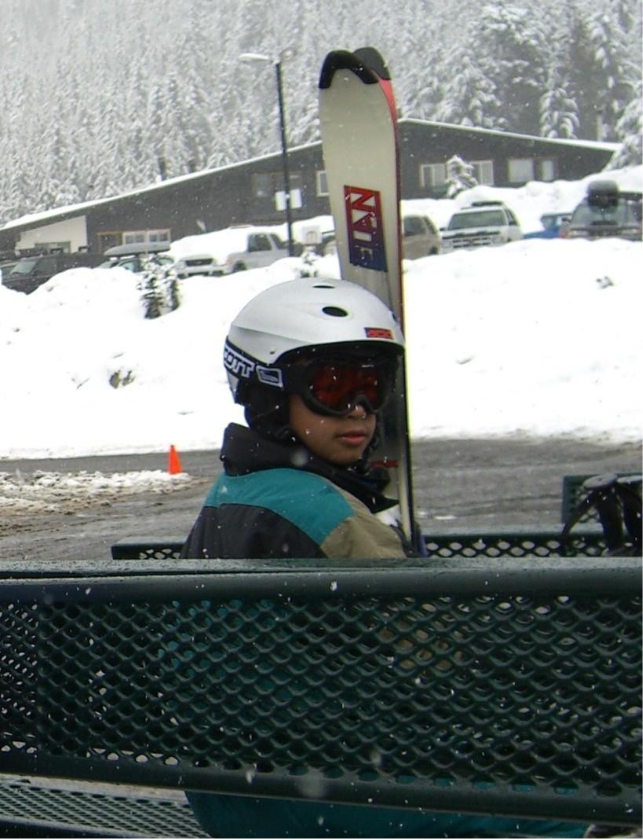
What Can Skiers Expect at Crystal Mountain?
Crystal offers a huge variety of terrain for all levels.
Beginner: The Discovery chair is one of the best in Western Washington. It features long, wide-open, mellow terrain that’s perfect for learning.
Family-friendly cruising: Forest Queen is where I spent a ton of time as a kid, and it’s still a favorite. You’ll find mellow greens and blues, plus fun side trails with tree skiing if you know where to look.
Steeps/expert terrain: Crystal is one of the steeper and more technical mountains in Washington State. Off Chair 6 and the Northway Chair, expect consequential steeps where, if you’re willing to hike, you can find some serious “no fall zone” skiing. However, the powder is what we call ‘All Time’.
3 Dryland Exercises to Prep for Skiing Crystal
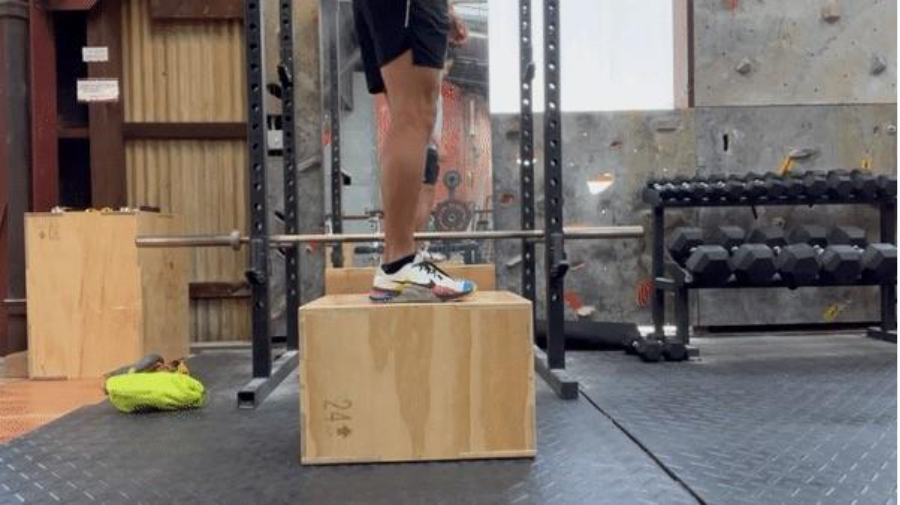
Whether it’s your first day at Crystal or your thousandth, PNW “Cascade Concrete” (heavy snow) can be a wake-up call if your legs and ankles aren’t ready. Start these 3x/week, beginning 6 weeks before your first ski day.
1) Mobility: Ankle Mobility (the #1 limiter I see)
If you can’t move forward at the ankle, you can’t get forward in the boot—which puts you in the backseat and fries your quads. Fix that first.
A. Calf stretch (soleus bias, standing “knee over toe”):
Stand facing a wall with your front foot ~2–4″ away.
Keep the heel down and gently drive the knee toward the wall over the toes (no collapsing arch).
Dosage: Do 10 oscillatory reps with a 3-second hold each; on rep 10, hold 30 seconds. Switch sides.
(Soleus = knee bent; if you straighten the knee, you’ll bias the gastroc instead.)
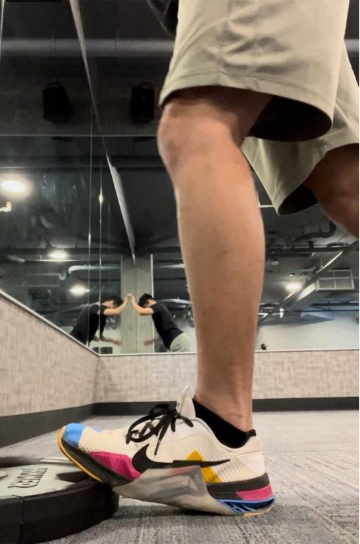
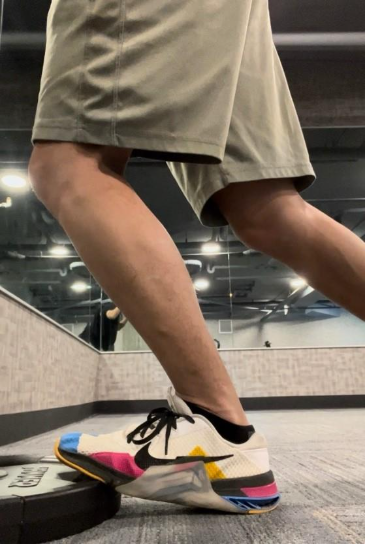
B. Tibialis anterior activation (toe raises/dorsiflexion):
Stand with your back against a wall for balance (with a light touch).
Lift your toes up toward your shins (keeping your heels on the ground), and gently control your lower back down.
Think: “Shin drives forward in the boot.”
Dosage: 2–3 sets to fatigue with a 3-second lower each rep; 45–60s rest.
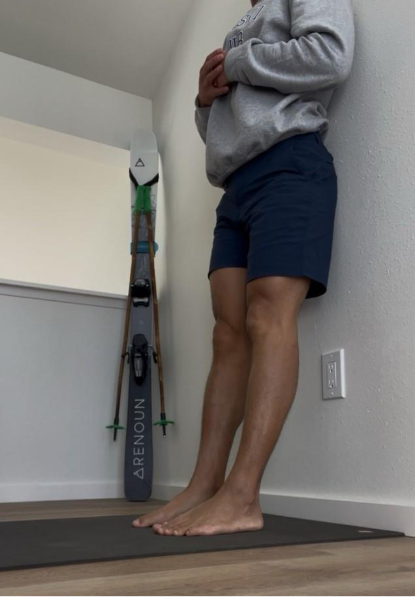

2) Ski Endurance: Eccentric Squats (focus on the descent)
Downhill skiing is controlled falling—your legs work eccentrically to absorb load.
How: From standing, drop into a squat quickly, pause 1–2s at the bottom, then stand at normal speed.
Work set: Go to technical fatigue (form starts to go), rest 60s, repeat x3 sets.
Progression:
Start evenly weighted,
Shift weight to bias one leg (e.g., 60/40 → 70/30),
Progress to single-leg eccentric squats as control improves.

3) Carving: Outside-Leg Balance & Fore-Aft Control
Carving well is all about a strong outside leg and managing fore-aft pressure.
A. Single-Leg RDL → Knee Drive
Why: Trains the forward-to-lateral transition and the rhythm of engaging edges.
How:
Stand tall on your stance leg (tripod foot).
Hinge at the hips to a soft “T”—back leg reaches long, spine neutral, hips square.
Drive the free knee forward to hip height, then return to the hinge position.
Keep the stance knee soft; avoid twisting through the pelvis.
Dosage: 6–8 reps/side, 3 sets, 60s rest. Slow control both ways.
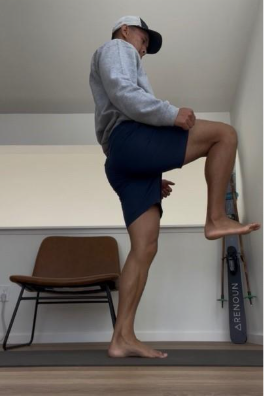
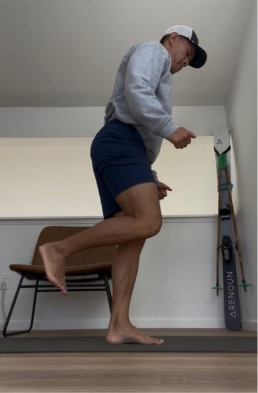

B. Hip Airplane (Warrior-3 style)
Why: Builds frontal-plane balance and edge-to-edge control over a single leg.
How:
Hinge to a soft “T” on one leg.
Open the pelvis (external rotation) without rotating the chest;
Close the pelvis (internal rotation) the same amount—hips move, torso stays square to the floor.
Keep the stance hip stacked; don’t collapse through the arch.
Dosage: 6-8 slow open/close cycles/side, 2–3 sets.


A person stretching in front of a mirror
Should You Prep Differently to Ski at Crystal vs. Other WA Mountains?
Short answer: yes—but not wildly different, just more specific.
Steeper sustained pitches: Crystal’s long fall lines and steeps (especially off Chair 6 and further out) demand increased eccentric endurance and the ability to commit to the fall line.
Variable, heavier snow: That “Cascade Concrete” requires stronger legs and often increased weighting and unweighting to allow the skis to turn.
Traverses & short hikes: Some in-bound zones require a hike to access the terrain, demanding increased aerobic capacity and leg endurance. This is where your dryland training pays off.
Advice Going Into the 25/26 Season
Crystal has evolved over the years, and so has the skiing experience. Here are my top tips to maximize your day:
Chase better snow timing. On freeze–thaw days (which can happen even in the dead of winter), ski sun-warmed aspects earlier and avoid them once they get heavy in the afternoon. You’ll minimize early-morning ice and late-day glue, keeping turns more consistent.
Carpool when you can. Parking is the limiting factor and carpooling helps everyone get on snow faster.
Start training ~6 weeks out. That’s the window your body needs to build strength and endurance that actually show up on snow.
Quit while you’re ahead. Most injuries happen when fatigue sets in. This is even more of a factor early in the season before you’ve had a chance to build your “ski legs”.
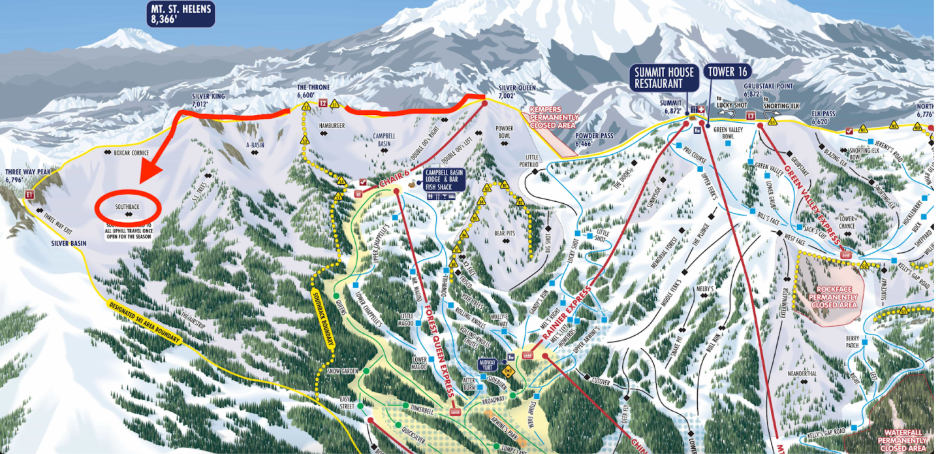
My Favorite Run at Crystal is Southback
You take Chair 6 (accessed from the top of Forest Queen), which is the highest chair at Crystal Mountain. If it’s a bluebird day, you get the most breathtaking view of Mt. Rainier. From there, you ski the traverse, then hike. Even on pow days, the extra effort often means better snow and sometimes untracked pockets.
Tips for Southback:
Keep your speed on the traverse. Getting stuck creates risks for you and those behind you; maintain momentum, and you’ll spend less time inching uphill. Let skiers pass if they are clearly faster than you.
Buddy up / communicate. It’s farther out and less immediately accessible; go with a partner and let someone know your plan in case something happens and ski patrol needs to be notified.
Mind the sun. South-facing aspects set up differently—in spring, it often gets heavy by afternoon. Aim for earlier laps on warm, sunny days.
Bring Avalanche Gear. Even though it’s in bounds and controlled by ski patrol, the slope is in avalanche terrain, and in my opinion, you can never be too safe.
If you’re interested in learning more about what it’s like to ski at Crystal and to connect with other skiers that call Crystal Mountain their home resort, come join our Facebook Group: Crystal Mountain – Mountain Community.
Also, if you’re skiing at Crystal this season, I hope these tips help you get the most out of your days. And if you see me out there, don’t be a stranger—say hi!
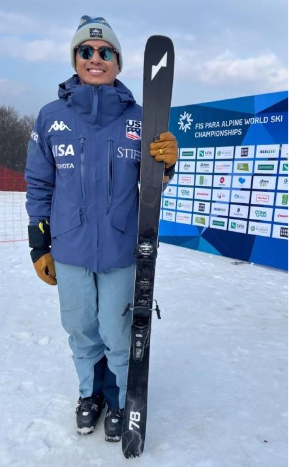
Greg Louie, better known as The Ski PT, is a Doctor of Physical Therapy, a ski-specific therapist, and the founder of Legacy Rehab & Performance and the Legaski Club. As a volunteer with the U.S. Ski Team, he combines world-class expertise in injury prevention, rehabilitation, and performance training to help skiers of all levels ski stronger and with more confidence. Greg shares resources through his coaching programs, the Legaski Podcast, and social channels, with the mission of keeping skiers healthy, resilient, and on the slopes for life.
📲Connect with him on IG @the_ski_pt
🎧 Tune into the Legaki Podcast
👥 Connect with like-minded skiers in the Legaski Club (Free) Community




